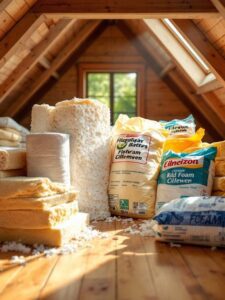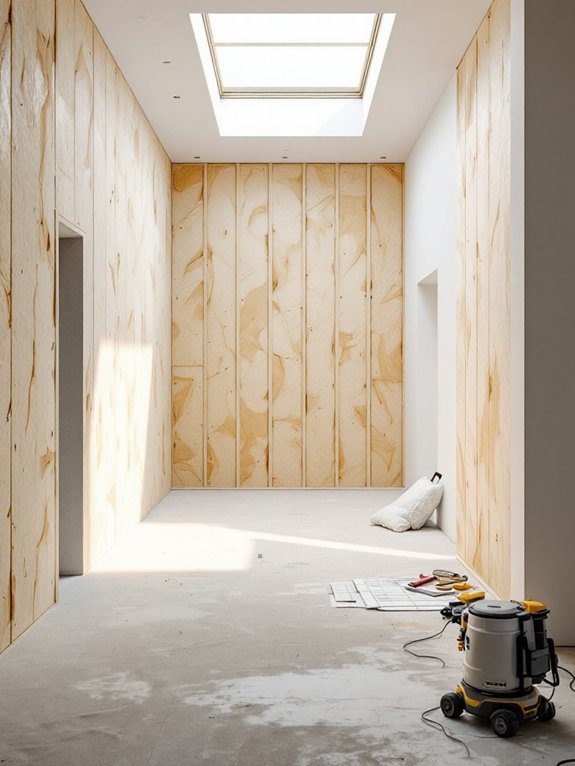Yes, you’ll find several loft insulation grants available for 2025 through major UK government initiatives, including the £1 billion Great British Insulation Scheme (GBIS) and ECO4 program. You’re eligible if your household income is under £31,000, you receive qualifying benefits, or your home has an EPC rating below D. Your property must have less than 100mm of existing insulation to qualify. Further details about specific schemes and funding options will help maximize your chances of approval.
Key Takeaways
- Yes, loft insulation grants are available through the Great British Insulation Scheme, which runs until March 2026 with £1 billion funding.
- Households with income under £31,000 or receiving benefits like Universal Credit can qualify for free or subsidized insulation.
- Properties must have an EPC rating below D and existing loft insulation less than 100mm thick to be eligible.
- Both homeowners and renters can apply, with potential savings of up to £445 annually on energy bills.
- Multiple programs are available, including ECO4, Home Upgrade Grants, and the Warm Homes Plan offering up to £15,000 per property.
Latest Loft Insulation Grant Schemes for 2025

The UK government’s commitment to energy efficiency has led to several substantial loft insulation grant schemes for 2025. You’ll find opportunities through the Great British Insulation Scheme (GBIS), which aims to retrofit 300,000 homes by March 2026 with its £1 billion budget.
The Energy Company Obligation (ECO4) scheme continues to partner with energy providers, while the Home Upgrade Grants (HUG2) and Warm Homes Plan offer additional support. Professional installation typically takes 4 to 8 hours to complete. Homes with less than 100mm of existing insulation are considered inadequate and may qualify for assistance.
Your grant eligibility typically depends on your household income, with thresholds around £31,000, and your home’s EPC rating. You can access various insulation types through these programs, including blanket, loose fill, sheet, and blown fiber options.
These installations can reduce your energy bills by up to £370 annually while lasting 40+ years, making them a valuable long-term investment.
Who Can Apply for Loft Insulation Grants?
Qualifying for loft insulation grants in 2025 depends on several key criteria, with eligibility primarily focusing on household income, benefits status, and property conditions.
You’ll likely qualify if you’re receiving means tested benefits like Universal Credit or Pension Credit, or if your household income falls below £31,000 annually.
Your property’s EPC rating should be below D, and you’ll need to live in council tax bands A-D in England or A-E in Scotland and Wales.
Even if you’re not receiving benefits, you can still be eligible based on your income thresholds or property’s potential for energy efficiency improvement.
Both homeowners and renters can apply, though tenants need landlord permission.
If you have disabilities or specific health conditions, you might qualify through additional support schemes.
The Great British Insulation Scheme offers these grants alongside the ECO4 program to help reduce energy costs.
Your property’s existing loft insulation must be less than 100mm deep to be considered for these grants.
Types of Insulation Covered Under Current Grants

Under current grant schemes, several types of insulation receive extensive coverage, with loft insulation forming the cornerstone of energy efficiency improvements.
You’ll find thorough support for loft insulation benefits, covering installations up to 270mm depth if your existing insulation is less than 100mm thick. Lower income households may qualify for complete cost coverage through these free insulation programs.
Beyond loft solutions, you’re eligible for cavity wall insulation if your home was built after 1920, while solid wall insulation supports pre-1920 properties. The ECO4 and GBIS grants remain available until March 2026.
The grants also extend to room-in-roof and underfloor insulation, ensuring complete home coverage.
Various insulation installation methods are available, including blanket, loose fill, sheet, and blown fiber options for lofts.
These improvements can greatly reduce your energy bills – you could save up to £590 annually with loft insulation alone, while cavity wall insulation offers savings between £180 and £690 yearly.
Financial and Environmental Benefits of Loft Insulation
Beyond immediate installation support, loft insulation delivers compelling financial and environmental advantages that extend far into the future.
You’ll see energy savings of up to 20% on your bills, with detached homeowners saving up to £445 annually. These benefits compound over the installation’s 40-year lifespan, making it a smart investment for your property’s value. Indoor air quality is significantly improved with proper loft insulation, helping prevent mold and dampness in your home.
The eco benefits are equally significant. When you insulate your loft, you’re joining a community of environmentally conscious homeowners who are actively reducing their carbon footprint. The Great British Insulation scheme makes these benefits accessible to homeowners regardless of their benefit status, focusing instead on EPC ratings and council tax bands.
Your home can cut carbon emissions by nearly 1,000 kg annually – equivalent to taking a car off the road for months. Plus, you’ll enhance your property’s marketability, as energy-efficient homes increasingly attract buyers and command higher resale values in today’s environmentally aware market.
Steps to Secure Your Loft Insulation Grant

To secure a loft insulation grant in 2025, homeowners must navigate through specific eligibility requirements and application procedures across two major schemes – the Great British Insulation Scheme (GBIS) and ECO4.
Your application tips should start with checking your eligibility checklist: verify your household income is under £31,000, verify your council tax band (A-D in England, A-E in Scotland and Wales), and confirm your property’s EPC rating is D or below.
You’ll need to demonstrate that your loft has less than 100mm of existing insulation. With proper installation, you could save up to £370 per year on your energy bills in a detached home.
Contact your energy provider directly for ECO4 applications or use official government portals for GBIS.
Professional installation costs for loft insulation typically range from £150 to £400 per day depending on your location and project complexity.
You’ll need a professional assessment of your property, and remember that only certified installers can perform the work.
Apply early, as these schemes run until March 2026, and funding availability may vary.
What to Expect During the Installation Process
Once you’ve secured your grant approval, understanding the installation process helps guarantee the best results for your loft insulation project.
Your installation timeline typically begins with a thorough assessment of your current insulation and necessary safety measures, including sealing air leaks and installing protective baffles around heat sources.
You’ll need to prepare your loft by removing debris and ensuring clear access for the installation team.
They’ll arrive with specialized equipment, particularly if you’re getting blown fiber or loose fill insulation. The installers will wear appropriate safety gear and follow strict protocols around electrical fixtures and chimneys.
Throughout the process, they’ll measure and verify consistent coverage to meet required standards.
Additional insulation layers may be installed perpendicular to joists for maximum thermal efficiency.
After completion, you’ll receive a final inspection to confirm all areas are properly insulated and ventilation remains unobstructed.
New Grant Developments and Future Opportunities

While the UK’s insulation grant landscape continues to evolve, several major schemes are shaping opportunities for homeowners in 2025.
You’ll find significant grant expansion through programs like the Great British Insulation Scheme, which aims to upgrade 300,000 homes by March 2026, and the new Warm Homes Plan offering up to £15,000 per property.
Multiple funding sources, including government initiatives and energy company partnerships, are making these opportunities more accessible.
If you’re receiving benefits like Universal Credit or Pension Credit, you’re likely eligible for support.
The ECO4 scheme and HUG2 program are particularly focusing on properties with lower EPC ratings, while regional initiatives are emerging to address local needs.
Properties with poor energy ratings are now key targets for ECO4 and HUG2 funding, complemented by local support programs.
These developments reflect a growing commitment to making energy-efficient homes more attainable for all UK residents.
With loft insulation costs ranging from £654 for terraced homes to £1,206 for detached properties, these grants provide substantial financial relief for homeowners.
Frequently Asked Questions
Can I Get a Grant if I’ve Previously Received Insulation Funding?
You can still apply for insulation grants despite previous funding if your home meets current eligibility criteria. Each scheme evaluates your application independently, so don’t let past grant receipts discourage you from exploring new opportunities.
How Long Does the Entire Grant Application and Installation Process Typically Take?
Like a well-orchestrated symphony, your grant journey unfolds over 2-6 weeks: a few days for application, 1-3 weeks for assessment scheduling, and just 4-8 hours for the actual installation to complete.
What Happens if Damage Occurs to My Property During Installation?
If your property’s damaged during installation, you’re protected by the installer’s insurance coverage. They’re legally required to fix any issues, and you can claim compensation if repairs aren’t properly addressed under PAS 2030 standards.
Can I Choose My Own Installer for the Grant-Funded Work?
You can’t directly choose your installer for grant-funded work. Energy providers select PAS 2030-2035 certified installers on your behalf. If you prefer choosing your own installer, you’ll need alternative funding options.
Will the Installation Process Create Much Dust or Mess in My Home?
You’ll experience minimal disruption as professional installers follow strict dust control protocols. While some dust is unavoidable during old insulation removal, teams maintain installation cleanliness standards and thoroughly clean up afterward.
Conclusion
You’ll find that loft insulation grants align perfectly with 2025’s energy efficiency targets, just as rising energy costs intersect with increased environmental awareness. While current schemes continue through early 2025, new funding phases are projected to roll out by mid-year. Track your eligibility through official channels and submit applications early – qualification criteria and available funding amounts typically shift with each policy update, impacting approval rates by 15-20% per quarter.
References
- https://ecoenergyservices.co.uk/blog/insulation-grant-heating-bills/
- https://whatcost.co.uk/insulation/grants/loft
- https://www.freeinsulation.co.uk/who-qualifies-insulation-grants/
- https://berksinsulation.com/blog/insulation-grants-guide-2025/
- https://warmauk.com/blog/insulation-grants-in-the-uk-your-2025-warma-guide/
- https://grantboilers.org.uk/blog/get-free-loft-insulation/
- https://grantboilers.org.uk/blog/free-insulation-grants-2025-qualify-apply-guide/
- https://www.greenmatch.co.uk/insulation/grants/loft
- https://berksinsulation.com/blog/gbis-home-insulation-grants-2025/
- https://atticexpertsky.com/why-invest-in-loft-insulation-for-better-roi/








